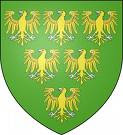Edward's story is a tragic one - of a life cut short and, like Prince Arthur, elder brother of Henry VIII, a life that promised so much. Edward was the only son of Henry VI and his Queen, Margaret of Anjou. He was born at Westminster, hence the name he is known by. Deprived by his birthright by the usurpation of Edward IV, Edward was forced to flee with his mother to the French Court, whilst his father was shabbily treated and kept a prisoner in the Tower of London. Whilst Edward remained in France, he was still a threat, and this is why Henry VI was kept alive. When Edward IV and his staunch supporter the Earl of Warwick finally fell out, Edward's chance to reclaim the throne for his father had arrived. Warwick fled with his family to France to beg Margaret of Anjou to join him in a plan to return her husband to the throne. The bargain was sealed with the marriage of Edward of Westminster, and Warwick's younger daughter, Anne Neville.
Warwick set off ahead of Margaret and her son, and was killed at the battle of Barnet. This left the 17-year-old inexperienced Edward of Westminster to lead the Lancastrian army at the battle of Tewkesbury, a role he did not shirk. George, Duke of Clarence, brother of Edward IV, was married to Warwick's eldest daughter, and was involved in the plot to restore Henry VI. He changed sides, and was now involved in the battle fighting with his brothers, Edward IV and Richard, Duke of Gloucester. There are varying accounts of how Edward died at Tewkesbury. One version has him killed in battle, whilst a more sinister version has him brought before the 3 York brothers, and, refusing to acknowledge Edward IV as king, was stabbed to death by all 3. He was hastily buried in Tewkesbury, with no tomb provided for him. Edward IV wanted no memory of Edward of Westminster, and his death sealed his father's fate - Henry VI was put to death in the Tower.
One can only try to imagine how devastated Margaret of Anjou was. Her beloved son, the Lancastrian hope, had been slain, and his death led to his father's. Margaret was imprisoned in the Tower and eventually released. She went back to France, and lived out her days there. She died in August 1482. If only she had lived a few more years, she would have seen the destruction of her bitter enemies, the Yorkists, and the Lancastrian cause led by Henry Tudor.
It's with some irony that George, Duke of Clarence, was later put to death on the orders of his own brother, the king. He too was buried in Tewkesbury, and the vault in which he was buried, along with his wife, regularly flooded, and now only several bones remain.
Also buried, eventually, in Tewkesbury, was Hugh Despencer, former favourite of Edward II.
The grill covering the vault of George, Duke of Clarence.
Tomb of Hugh Despencer.
Tewkesbury Abbey







No comments:
Post a Comment